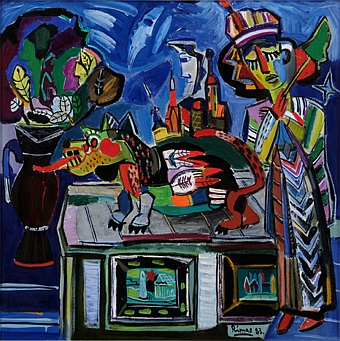With his landscapes, still lifes and portraits of intense colour, Rimas Zigmas Bičiūnas belongs to the naïve-folk section in the collection. Bičiūnas studied at the Academy of Fine Arts in Vilnius. His most frequent themes are allegorical compositions or scenes related to recreation and leisure. His style is close to naïve art, and a broader formal and aesthetic parallel can be drawn with Chagall’s painting, expressionism and primitive painting, which has a great tradition in Russia. Bičiūnas described his work as follows: “I paint what I feel, what I can sense. I would like to depict the things that suddenly erupt in me as a result of sudden impressions, and I make several variations. I often return to subjects that I painted years before. I devote a lot of time to the representation of Lithuanian people in their own environments, in Lithuanian villages.” His piece in the collection of Ludwig Museum, entitled Still-Life with Folk Sculptures bears the aforementioned characteristics. The figure depicted in the style of icons, the strange animal from folk tails, represented on the chest adorned with pictures, and the vase – as suggested by the title, these might all be characters and objects of the Lithuanian countryside. The majority of Bičiūnas’s works were conceived at a time when Lithuania was part of the Soviet Union. The aggressive sovietisation had evoked strong national resistance, and thus the representation of the Lithuanian countryside can be interpreted as a gesture of political resistance.
